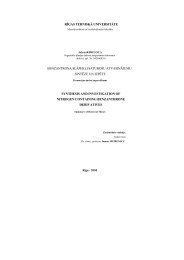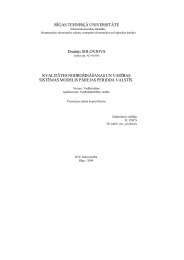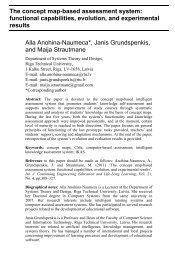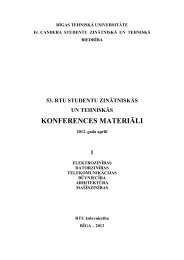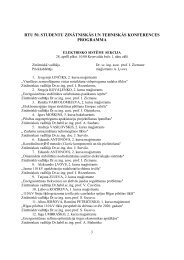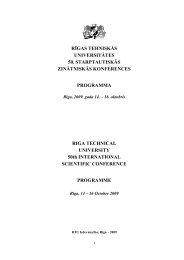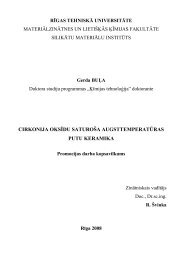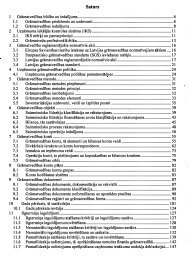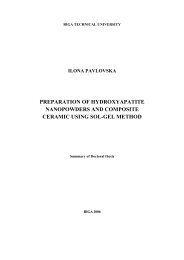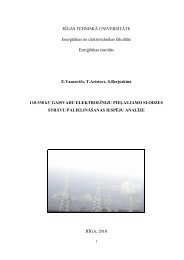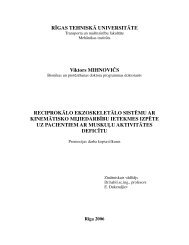OPTICAL PROPERTIES OF SiOj/Si STRUCTURE ... - Aleph Files
OPTICAL PROPERTIES OF SiOj/Si STRUCTURE ... - Aleph Files
OPTICAL PROPERTIES OF SiOj/Si STRUCTURE ... - Aleph Files
You also want an ePaper? Increase the reach of your titles
YUMPU automatically turns print PDFs into web optimized ePapers that Google loves.
<strong>OPTICAL</strong> <strong>PROPERTIES</strong> <strong>OF</strong> <strong><strong>Si</strong>Oj</strong>/<strong>Si</strong> <strong>STRUCTURE</strong>FORMED BY YAG:Nd LASER RADIATIONA.Medvid'\ P.Onufrijevs\ E.Mellikov^ D.KropmaIl^F.Muktepavela\ G.Bakradze^ and P. Gavars''Riga Technical University. 14AzenesStr.] LV-1048. Riga. Latvia^Tallinn University of Technology. Ehitajate tee 5. 19086 Tallinn. Estonia^University of Latvia. 8. Kengaraga Str. LV-1063. Riga, LatviaAbstractThe change of optical properties of <strong>Si</strong>O2 layer on <strong>Si</strong> single crystal exposed to YAGrNdlaser radiation has heen found experimentally. Before irradiation the <strong><strong>Si</strong>Oj</strong> layer withthickness 0.70 nm had red color in reflecting light due to the interference. Afterirradiation by the laser it has changed red color to yellow one. However, samples withthickness 0.21 )xm did not change color after irradiation.Dielectric pennittivity (K) of <strong>Si</strong>O2 layer is decreased!more then 40% after irradiation.We suppose that after irradiation ofthe <strong>Si</strong>O2 layer decrease of K takes place due to theformation of nanopores in <strong>Si</strong>O2 or/and generation of the charged point defect at theinterface of <strong>Si</strong>-<strong>Si</strong>O2. Particularly it is in agreement with measurements of microhardness and capillary effect.Keywords: <strong>Si</strong>O2 layer, laser radiation, dielectric pennittivity, low-K, <strong>Si</strong> single crystalIntroductionChange of optical and electrical properties of <strong>Si</strong>O2 glass is a very importanttask for solid state physics and applications in optoelectronics andmicroelectronics. An example is a reduction of dielectric permittivity (K) -leading to "low-K" of dielectrics [1]. Low-K dielectrics have a reducedparasitic capacitance in integrated circuits (ICs). One ofthe ways to reduce K isto use porous low-K dielectrics [2, 3]. However, materials with micrometricsize of pores at the surface become brittle, and can absorb a photoresistcontaminating it. Another potential way is to use Fluorinated <strong>Si</strong>licate Glass [4]instead of <strong>Si</strong>licon Dioxide. It means that impurities in the <strong>Si</strong>O2 can change ofoptical properties of <strong>Si</strong>O2 glass. In paper [5] the possibility to reduce lightabsorption near the absorption edge is shown for <strong>Si</strong>O2 doped by fluorine andirradiated by F2 laser. This fact is explained by photolysis of interstitial O by F2laser irradiation. This work assumed that results of interaction of stronglyabsorbed laser radiation (LR) with <strong>Si</strong>O2 leads toj growth of the peroxy radicals<strong>Si</strong>-0-0 and decrease of the concentration of dangling oxygen bonds = <strong>Si</strong>-O244
known that if an absorption factor (a) is changed, then a reflection factorwill be changed simultaneously, but n =>/K^ , K is the real part of dielectricittivity. We can conclude that K could change due to both fonnation ofes or/and generation of new defects. Of course, change of defectscentration leads to gradual change of optical parameters of material.oxygen vacancy can generate two kinds of defects, depending on its electricrge: E and B2 centres. The E (Os<strong>Si</strong>*) and B2 (O=<strong>Si</strong>-S=O) centres areonsible for Uie well-known absorption bands at 214 and 248 nm,ectively. Photoluminescence studies show that an emission band at 400 nmssociated with B2 centres.ther defect, which can be generated is a nonbridging oxygen hole centreOHC: O=<strong>Si</strong>-O') responsible for a PL band at 650 nm. Finally, as a result ofoxygen displacement, certain regions of the implanted sample have aness of oxygen, that can lead to creation of peroxy radical defectsR:Os<strong>Si</strong>-O-O*). These defects are less studied than the E and B2 centres orOHC defects [7].aim of this study is experimental instigation optical properties changes of2 on <strong>Si</strong> effected by YAG:Nd laser radiation.erimental part- and n-type with <strong>Si</strong>O2 top layer used in our experiments. <strong>Si</strong>O2 was grownthermal oxidation method. The thickness of <strong>Si</strong>O2 layers were 0.7 nm andnm. The <strong>Si</strong>O2 layer with the 0.7 \im thickness (thick samples) had redur in reflecting light due to the interference. The <strong>Si</strong>O2 layer was irradiatedYAG:Nd LR (wavelength X = 532 run, pulse duration T= 10 ns). Thensities of LR were from 3.5 MW/cm^ till 20 MW/cm^. Optical microscope,mic force microscope, method of capacity-voltage characteristics,rohardness measurements. X-ray luminescence were used in theeriments. The experiments were carried out at room temperature andospheric pressure.ults and discussion<strong>Si</strong>O2 layer is transparent for second harmonic of YAG:Nd laser radiation,<strong>Si</strong> is strongly absorbed. The <strong>Si</strong>O2 layer with thickness 0.7 |xm had red coloreflecting light due to the interference. Afiter irradiation by the laser withnsity 1= 20 MW/cm^ the <strong>Si</strong>O2 layer has changed the red color to the yellow. It could be explained by change of optical path (see Fig. 1 profilerasurement). However, samples with thickness 0.21 \im did not change colorr irradiation.asurement of capacity (C) afiter irradiation of Al/<strong>Si</strong>O2/<strong>Si</strong>/Al structure wither thickness 0.21 nm by capacity - voltage (CV) characteristics method, has245
shown decrease of C to more than 40%. It is possible if dielectric permittivity Kdecreases or thickness of the <strong>Si</strong>O2 layer increases. Atomic force microscopemeasurements did not show any change of the <strong>Si</strong>O2 layer thickness. It meansthat after irradiation of the <strong>Si</strong>O2 layer decreasetakes place. We suppose that such change offonnation of nanopores in <strong>Si</strong>O2 or that generationof K - low-K dielectrics [1]K-factor occurs due to theof new defect at the interfaceof <strong>Si</strong>-<strong>Si</strong>O2 takes place. Particularly this is in agreement with measurements ofmicrohardness, using a precision microhardness tester at small test loadings.Microhardness test was performed using a microhardness tester PMT-3 withoriginal self-adjusting loading device, allowing to carry out precisionmicrohardness measurements at very small test fading (starting from 1.5mN)[8]. The indentor used was a Vicker's diamond pyramid and relaxation timewas 15s. After irradiation both microhardness and brittleness of <strong>Si</strong>O2 decreases,that could be connected with the relaxation of intemal stresses due to thenanopores. At the same time, near the interface microhardness increases, thatcould be explained by the formation of defects at the <strong>Si</strong>-<strong>Si</strong>O2 interface afterirradiation. An evidence of the pores formation in <strong>Si</strong>O2 layer is the presence ofcapillary effect which was observed at chemical treatment of <strong>Si</strong>O2/<strong>Si</strong> in HFacid. A measurement of n from ellipsometry is in agreement with ourhypothesis. Measurement of X-ray luminescence at room temperature hasshown presence of spectral band with maximum at 2.3eV which corresponds toself-trapped exiton in glass <strong>Si</strong>O2 [6].After irradiation by the laser this band intensity arises 2 times and does notdepend on intensity of LR. Influence of the interference on the luminescencespectrum has been taken in to consideration for mterpretation of luminescencefrom multilayer structure [9].y,mn600,0:--200 400 600 800 1000 1200 1400X, jLimFig. 2 Profile of <strong>Si</strong>O2/<strong>Si</strong> thick sample after laser radiation measured byDEKTAK 6M BENCH-TOP STYLUS PR<strong>OF</strong>ILER. The size of <strong>Si</strong>O2 isdecreased by 180 mn.246
P2-35point of view of solid state physics it is very important to study theual decrease of K in materials where luminescence takes place throughon recombination [6]. Decrease of K leads to increase of an exiton radius atsame Coulomb force of interaction between an electron and a hole in anon. It may be possible to observe a transition localized exiton - free exitonocalised). And lastly, decrease of K could lead to blue shift of an exitontoluminescence (PL) spectrum at the same radius of exiton.clusionshe decrease of dielectric permittivity of <strong>Si</strong>O2 layer after irradiation byG:Nd laser is explained by formation of nanopores in <strong>Si</strong>O2 and possibly byation of the charged point defects at the <strong>Si</strong>-<strong>Si</strong>O2 interface.he colour change of <strong>Si</strong>O2 layer (for the 0.7 nm samples) can be explaineddecrease of the <strong>Si</strong>O2 layer thickness due to sublimation of <strong>Si</strong>O2 andation of nanopores at the <strong>Si</strong>-<strong>Si</strong>O2 interface.erencesWolf, Stanley: <strong>Si</strong>licon Processing for the VLSI Era, 4: Deep Submicron ProcessTechnology, Lattice Press, 2002.Aiichiro Nakano, Lingsong Bi, Rajiv K. Kalia, and Priya Vashishta Structuralcorrelations in porous silica: Molecular dynamics simulation on a parallelcomputer Phys. Rev. Lett. Vol.71, pp.85-88,1993.J. L. Cautin, M. Schoisswohl and H.J. von Bardelehen, Chapter 15 in Structuraland Optical Properties of Porous <strong>Si</strong>licon Nanostructures, ed. By G. Amato, C.Delerue and H.J. von Bardelehen (Gordan&Breach, 1997), Vol. 5, p.4O9.Shiuh-Ko jang lean, Ying-lang Wang, Chuan-Pu Liu, Weng-<strong>Si</strong>ng Hwang, Wei-Tsu Iseng, Chi-Wen Lin. In situ Fluorine-modified organosilicate glassprepareed by plasma enchanced chemical vaporisation. Journal of AppliedPhysics, V.94N1,2003.K. Kajihara, Y. Dcuta, M. Oto M. Hrano L. Skuja, H.Hosono, UV-VUV laserinduced phenomena in <strong>Si</strong>O2 glass. Nuclear instruments and Methods in PhysicsResearch B 218, pp.323-331, 2004.A.R. <strong>Si</strong>lins, A.N. Truhin. Point defects and elementary excitations in crystallineand amorphous <strong>Si</strong>O2, Riga, Zvaigzne, 1985.C Barthou, P.H.Oliver, T.Itoh and P.Lavallard. <strong>Si</strong>locon nanocrystals and defectsproduced by silicon implantation in silica. J.AppI. Phys. Vol.93 , pp.10110-10113,2003.F.Muktepavela, I.Manika, V.Mironovs. Structure and mechanical properties ofAl-B composite powder. MaM)es/gn, Vol. 18, 257-259,1997.S.M.Orhons, M.G.Spooner, R.G.Elliman. Effect of material structure onphotoluminescence spectra from silicon nanocrystals. J.AppI Phys.Vol.96,pp.4650-4652,2004.247



